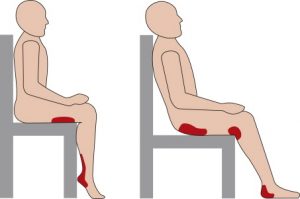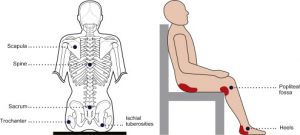- Home
- Up to XII Students
- Decide Stream For XI & XII
- Career Options
- Entrance Preparation
- Sample Papers
- Entrance Exams after 12th
- International Entrance Exams To Study Abroad
- Foreign University Comparison
- Apply to Foreign Universities
- General Preparation For Students Going To Study Abroad
- Write A Report
- Write an Article
- Write An Essay
- Important Dates
- UG & PG
- Tech Tips
- Mock Test
- GROOMING
- HOBBIES
- K PLUS
- Working Professional
- OTHERS
APPROPRIATE SEATING FOR PREVENTING PRESSURE ULCER
Dr. Vinay Chandra Jha
Professor - Mechanical Engineering Department
INTRODUCTION
Nowadays every manufacturer related health professional focuses on making beds and mattresses but they forget about the chair and cushion as we all know that in hospital many patients spend their all-day seating on a chair so it is very necessary to focus on making chair for preventing pressure damage and also for preventing pressure ulcer. Though it is very easy for everyone to seat on the chair many people don’t know about the logic about their making there are so many calculations needed for it like how much stress should be required, how a force can impact seating, what anthropometric data should be required from 5th percentile to 95th percentile, etc all these things should be kept in mind by a manufacturer if they want to make it properly and for the long period.
In the article Tissue viability society (in 2013) author discussed types of cushions available in different places like offices, cars, hospitals, etc mainly focused on the manufacturer’s clinical research regarding chairs and sofa and their comparisons with mattresses and beds.
LITERATURE REVIEW
- NPUAP (2018) – According to this association every stable person should sit on the chair at least for 60 min. along with that they also mentioned that sitting continuously for 2 to 3 hr. may cause a pressure ulcer.
- ACA American chiropractic association (2014). This association also suggested that sitting for a long period may issue a back problem though they didn’t mention the exact time for the sitting period.
- Mamau (2013) According to him a proper sitting position should be made concerning the chair back along with that arm of a person should be positioned on the armrest, no rubbing between the knees, the foot should be parallel to the floor and person back should be properly fitted concerning the chair back.
- Stockton and Rithalia (2013) According to them there should be movement after every 15 min. however, NICE (National Institute of health and care Excellence) suggested no movement till 60 min.
So these researches make the typical situation for every researcher to find an ideal sitting position.
OBJECTIVE: To describe the ideal sitting comfort for the patient.
PROBLEM OCCUR DURING SITTING
While making an observation some problem occurred regarding the sitting posture of the human body from figure 1 it is seen that chair (a) height is much longer while chair (b) height is smaller

So if the sitting is too high as shown in fig. 1 (a) person has to come forward to place his or her feet on the ground. This may cause back or knee problem but if one sees the chair (b) of fig.1 then it is seen that chair height is too low which cause a force to the patient buttocks ischial tuberculosis and heel along with that pressure will also increase in this area?
Similarly from figure 2 it is seen that chair (a) seat is too short (b) too long

As one can see in fig. 2 (a) seat is too short which cause a risk of slipping to the patient along with that huge pressure will apply to the buttock, ischial tuberosities and in (b) as one see the seat is too long which cause a risk of shear breakage of buttock region and also patients have to slide forward to set their feet on the ground.
So by keeping in mind this problem a seat along with a cushion should be designed according to the anthropometric data which describe following:
USE OF CUSHION
In every chair cushion is the most important part as it helps to reduce the pressure of the patient while sitting so it is very necessary for the manufacturer to collect anthropometric data of humans during seating however following are the anthropometric data of the human body during seating explained by figure 1.
Figure 1 human sitting according to ANTHROPOMETRIC DATA
Table 1. ANTHROPOMETRIC DATA OF THE HUMAN BODY
| Body dimension | sex | 5th | 50th | 95th |
| 6 Sitting height, erect | M | 33.1 | 35.7 | 38.1 |
| F | 30.9 | 33.5 | 35.7 | |
| 7 Eye height, sitting | M | 28.6 | 30.9 | 33.2 |
| F | 26.6 | 28.9 | 30.9 | |
| 8 Elbow rest height | M | 7.5 | 9.6 | 11.6 |
| F | 7.1 | 9.2 | 11.1 | |
| 9 Thigh clearance height | M | 4.5 | 5.7 | 7 |
| F | 4.2 | 5.4 | 6.9 | |
| 10 Knee height | M | 19.4 | 21.4 | 23.3 |
| F | 17.8 | 19.6 | 21.5 | |
| 11 Buttock knee length | M | 20.4 | 23.4 | 25.3 |
| F | 21.3 | 22.4 | 24.6 | |
| 12 Popliteal height | M | 15.4 | 17.4 | 19.2 |
| F | 14.0 | 15.7 | 17.4 |
So if a manufacturer designs a chair according to these data so it will provide comfort to the human body while sitting.
References
- American Chiropractic Association (2014) Tips to maintain good posture. www.acatoday.org/content_css.cfm?CID=3124 (accessed 14.10.14)
- Mamau M (2013) Pressure ulcers and skin care. www.netce.com/ coursecontent.php?courseid=931 (accessed 10.10.14)
- National Institute for Health and Care Excellence (2013) The management of pressure ulcers in primary and secondary care. Clinical Guideline 29. NICE, London www.nice.org.uk/cg29 (accessed 14.10.14)
- Tissue Viability Society (2013) Seating and Pressure Ulcers. Clinical Practice Guideline. Cardiff, UK. www.tvs.org.uk (accessed 09.09.14)
- Stockton L, Rithalia S (2013) Is dynamic seating a modality worth considering in the prevention of pressure ulcers? J Tissue Viability 17(1): 15–21
Like this article?

Kalinga Plus is an initiative by Kalinga University, Raipur. The main objective of this to disseminate knowledge and guide students & working professionals.
This platform will guide pre – post university level students.
Pre University Level – IX –XII grade students when they decide streams and choose their career
Post University level – when A student joins corporate & needs to handle the workplace challenges effectively.
We are hopeful that you will find lot of knowledgeable & interesting information here.
Happy surfing!!
- →
-
Free Counseling!
